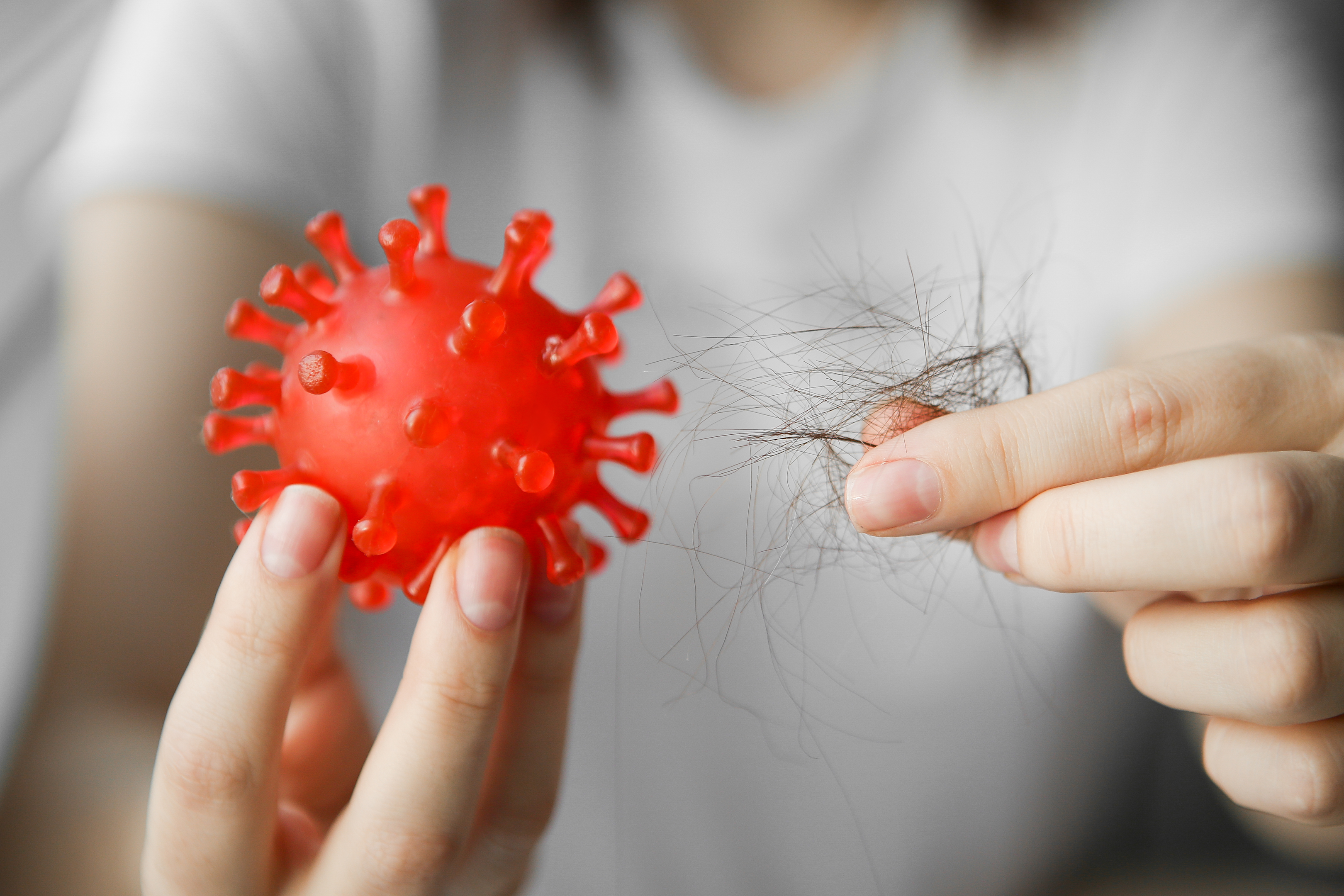Can hair loss occur after COVID?


Some patients have reported temporary hair shedding after recovery from the coronavirus infection.

The coronavirus disease caused a large number of clinical presentations, most of which were respiratory. However, with time, many different long-term effects surfaced.
One of these effects is hair loss. Hair loss was reported by some people who have recovered from the infection. Some people who were already experiencing hair loss had their symptoms worsen with the infection. Several factors were identified for this phenomenon.
This article will explain how the coronavirus infection causes hair loss, the possible symptoms to be noted and what you can do to reverse or slow down the process. We will also tell you when to seek a doctor. Before moving forward, let me explain why hair loss occurs in the first place.
Hair growth occurs in a continuous cycle known as the hair cycle. Broadly, there are two phases of this cycle: anagen, the active growth phase, and telogen, the resting phase. Between these phases is a brief catagen phase which marks the end of the growing phase.
Anagen is the longest phase; its average duration is 2-6 years. For a normal scalp, 85-90% of the hairs are in this phase.
Read more: Hair growth explained

The hair follicles in the resting phase shed their hair threads, which grow back in the growing phase. So, losing 50-100 hairs daily from a full scalp is normal. However, sometimes, due to various causes, a person can start losing more hairs than are being replaced. It will result in hair thinning, low hair density and the appearance of bald patches on the skin, a condition known as hair loss (the medical term is alopecia).
Besides the scalp, it can occur in any part of the body with hair. However, for various reasons, people are more concerned about hair loss from the scalp.
If you are losing more threads than usual, what could be the cause? A vast array of causes of hair loss. The most important cause of hair loss is androgenic alopecia, also known as female or male pattern baldness. It occurs due to some hereditary factors which cause increased sensitivity to the DHT, causing hair thinning.
It has a predictable pattern with age and worsens with age. However, genetics is not the only thing to be blamed for hair loss. Some other factors also cause the prolongation of the resting phase and the shortening of the growth phase. Some additional causes responsible for hair loss are;
Nutritional deficiencies, e.g., the deficiency of iron, B vitamins, copper, zinc, vitamin D etc.
Various stress factors (the hair loss due to stress is known as telogen effluvium, and various types of psychological and emotional disturbances, physical trauma and the use of some drugs can trigger it)
The use of some drugs, e.g., the drugs used for anticancer chemotherapy, hypertension drugs and antidepressants etc.
Stressful grooming practices cause too much pressure on the hair threads. This form of hair loss is known as traction alopecia.
Some health conditions, e.g., fungal infections of the scalp (e.g., tinea capitis infection), trichotillomania (the hair-pulling disease, resulting in an uncontrollable urge to pull out the hairs), autoimmune conditions (alopecia areata) etc.
The hormonal changes occurring during thyroid diseases, menopause and pregnancy etc.

So, losing hair is a very complicated issue, and several factors can be responsible for it. It would help if you viewed every excessive hair shedding with suspicion. Let's see how the infamous coronavirus infection can lead to hair loss and what you need to do about it.
COVID-19 causes an acute short-term disease, but some long-term effects are also reported. Not only COVID-19 but any acute or chronic stress can cause a type of hair loss known as telogen effluvium. Any stress can exacerbate hair loss due to other causes.
Telogen effluvium is a severe scalp disorder characterized by excessive and sudden hair loss. Several factors responsible are physiological stress, emotional disturbances, trauma, drugs etc. Hairs fall in large clumps while showering and brushing.

The cause of hair loss is often forgotten because mostly the telogen effluvium develops a few months (2-3 usually) after the triggering event. However, not all of the scalp is usually affected, and it is reversible and lasts for 6-9 months. The lost hair mostly regrows after this period unless other factors compound the situation.
But how does COVID-19 cause hair loss? A high-grade fever and its nature of it as an acute disease can be the main factors causing hair loss. Also, COVID-19 is associated with emotional stress and depression. For example, a study published in the Frontiers in Psychiatry in 2021 noted that the danger of acquiring the disease and the fear of contamination are the most common stressors.
To control the spread of disease, various isolation methods were employed e.g., strict quarantine, which is very stressful in its own right.
Various case reports from COVID-19 patients and research and survey studies have noted hair loss due to COVID-19.
A very recent study published by Cureus in 2022 showed that coronavirus patients experienced a variable degree of hair loss. Various factors identified were the high-grade fever, the presence of previous hair loss issues, advanced age and gender (being female). A total of 806 participants were included in the study, and 52.7% experienced hair loss.
Another research published by the Irish Journal of Medical Science in 2022 noted that COVID-19 induced acute telogen effluvium in patients. All 39 patients enrolled in the study experienced hair loss after 2-3 months of the infection and showed strong positive pull test results.
Another review published by the Journal of Cosmetic Dermatology in 2022 noted that telogen effluvium was the most common cause of hair loss after covid. It was noted that the vast majority of the affected people were women (82.8%), the median time of onset of hair loss was 2 months, and the condition resolved in an average of 5 months in 95% of the patients.

COVID-related hair loss is a reality for many people. People who have hair loss because of other issues (e.g., androgenetic alopecia) experience more severe hair loss.
The effects of Covid-related hair loss are variable from person to person and also depend upon the individual's ability to manage the stresses and various other social and psychological factors that accompany the live virus.
Several studies have noted that severe COVID-19 virus cases cause more robust hair loss, but are reversed more rapidly. The chronic and prolonged COVID infection causes slower hair loss, but it takes much longer to reverse.
The use of Covid vaccines is also thought to be responsible for hair loss. These claims have research backing. For example, some studies have shown a loose connection between alopecia areata and coronavirus vaccination, as a small percentage of people receiving the vaccination experienced patchy hair loss.
However, the same studies noted that such individuals were likely to be at a higher risk of this condition. The medical community quickly discredited such claims with the rationale that the benefits of COVID vaccination outweigh any such side effects.
The good news is that except for the specific type of hair loss: androgenic alopecia, almost all other types of hair loss are reversible as soon as the cause is removed. The research has also noted that hair loss due to the coronavirus infection recovered within 2-6 months.
However, it has been quite a long time, and it has been observed that shedding hair becomes a cause of worry in itself, leading to a more exacerbated situation.
Hair loss is one of the most sensitive issues, particularly for younger people. The typical steps for diagnosing a hair loss condition include,
As mentioned earlier, the male and female pattern baldness is due to some inherited factors. So, a family history review will provide clues to the physician.
A physical examination of the scalp, e.g., to diagnose fungal scalp infections and existing health issues will help the clinician.
The doctor may ask questions about your diet, the use of medicines, the hair styling and grooming practices etc., to sort out the issue.
The scalp pull test will help to know the extent of hair loss. During this test, the dermatologist will grasp small sections of the hairs (around 40 threads) from various areas of the scalp. Then a gentle tug will be applied. The results are considered positive if more than 10% of the hairs in the bundle are pulled off.

It will allow the dermatologist to estimate the percentage of hairs in the telogen phase and determine the extent of hair loss.
The examination of hair shafts and hair follicles under the microscope will allow the dermatologist to compare them to normal hairs.
Blood tests can be useful to detect the health conditions responsible for hair loss, e.g., higher DHT levels etc. These tests will also screen the presence of pathogens which could be responsible for the issue.
At Welzo.com, we have a test kit, ''Hair Loss Blood Test,'' which can help you to identify the cause of hair loss. It detects various biomarkers in the blood related to hair health, e.g., hs-CRP, TSH, free thyroxin, ferritin, SHBG, free androgens and testosterone. You will get trusted results at your home within 2 days. Click here to get your test kit.
If you have hair loss, you may be looking for treatment options. The treatment options depend upon the cause. For a successful treatment, you need to treat the underlying health condition first. For example, if hair loss is due to certain drugs you are using during or after Covid, you should discuss with the doctor for replacement.
Some commonly available treatment options to treat hair loss are;
This drug is available in various brand names (e.g., Propecia and Proscar) and stimulates hair growth and prevents hair loss. It also lowers the DHT levels by preventing its synthesis. But Finasteride from the Welzo pharmacy here.
This drug is available in various brands (e.g., Rogaine) and as a topical spray of variable strength. Its regular use for months promises hair regrowth and slows down hair loss. It is available over the counter at local pharmacies and superstores.
It shortens the telogen phase and lengthens the anagen phase. Thus, the hair follicles spend more time in the growing phase.
Buy Minoxidil products here.
Corticosteroids calm down the overactive immune system. So, the injections of corticosteroids in the local area can work against the autoimmune-related causes of hair loss (alopecia areata). An earlier study published in the Nigerian Medical Journal in 2015 noted that it has 80% efficacy in treating alopecia areata.

Its use in women has also reduced hair loss and increased hair thickness. It encourages hair regrowth by reducing the production of androgens in females.
It is a lengthy surgical process in which the cosmetic surgeon or the dermatologist removes hairs along with hair follicles from one part of the scalp and transplants them into the other part having hair loss. Although it is a complicated process, it is the permanent solution to hair loss.
The PRP is a novel technique in which platelet-rich plasma is injected at various sites on the scalp to stimulate hair regrowth.
Several vitamins and minerals are known to have a role in hair growth. Enrich your diet to contain more minerals and vitamins. In case of swerve deficiencies, consult the doctor or nutritionist for nutritional supplements. Besides these, several essential oils also promote hair growth. The common nutrients recommended for hair loss are biotin, vitamin D, zinc, etc.
As a general rule, you must avoid anything harsh to your hair, e.g., chemicals. Manage your lifestyle to reduce any physical and emotional stress. The following lifestyle tips can also be helpful;
Don't apply too much pull or tugging while brushing
Tight braids, hair extensions, ponytails and various other hairstyles that put pressure on the hair should be avoided.
Avoid any treatments that can damage the hairs, e.g., hot air, chemicals, perms, hot air etc.
Hair loss is a distressing spectacle, and you need to consult the doctor at the first noticeable sign, as the worries related to hair loss will further fuel the fire. Serious hair loss is likely due to serious health issues that other clinical signs must accompany.
Look for other signs, e.g.,
Tenderness and itching on the scalp
Patches and bald areas on the scalp
Hair falling in clumps
There is sudden and heavy hair loss.
The psychological and emotional disturbances due to COVID-19 restrictions, the fear or grief of losing loved ones, the use of certain drugs and medications and vaccines, etc., all can contribute to increased hair loss by COVID patients. The cause of COVID hair loss in most cases is chronic telogen effluvium.

However, it is reversible in most cases, and some drugs, nutritional modifications, stress management and lifestyle modifications can help reverse it. If, however, it doesn't reverse after a few months, don't worry; we have many treatment options for hair loss. Click here to select your desired treatment after consultation with our health professionals.
We have detailed the science behind various hair loss treatments in another article. Click here to read it.








Plus get the inside scoop on our latest content and updates in our monthly newsletter.